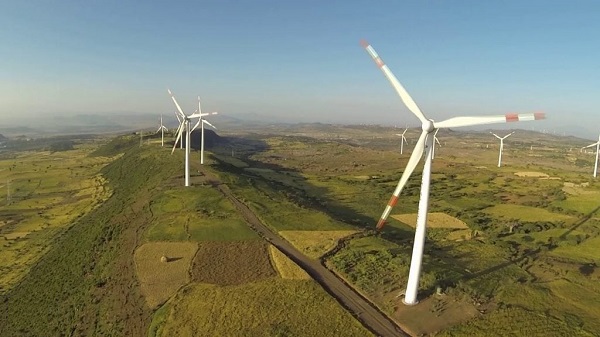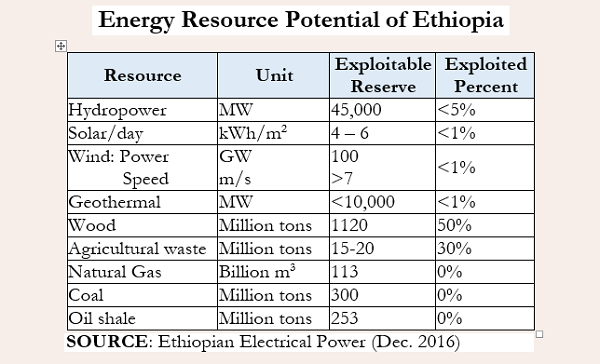
Ethiopia has abundant renewable energy resources and has a potential to generate over 60,000 megawatts (MW) of electric power from hydroelectric, wind, solar and geothermal sources.
By Robel Yohannes (The Ethiopian Herald) |
As sources that are naturally replenished and produce few, if any pollutants, renewable energy are not only mere source of energy, but they are also critical to stopping global warming. In an era, where global climate change has become an almost existential issue, their extraction and use is important.
Ethiopia is a country that is very well endowed when it comes to renewable energy resources. Its vast portfolio of renewable energy includes wind, geothermal, solar as well as biomass. Due to the country’s rapid economic growth, and the fact that Ethiopia is serious about transitioning to green economy makes exploiting its renewable energy resource important.
According to Ministry of Water, Irrigation and Electricity, Ethiopia has the potential of 45 thousand MW hydro-power, five to 10 thousand MW geothermal potential, and 1000 GW wind energy potential, among others. However, despite the headway made in exploiting this vast potential, still only a small portion of that potential remains harnessed.

There are various factors, or in other words challenges, that influence the activities to exploit the renewable energy resources of the country – factors that must be kept in mind while trying to harness the resources. According to Sahele Tameru, Director of Energy Research and Development with Ministry of Water, Irrigation and Electricity, these challenges can be put in two aspects – which are (low level of) implementation capacity and finance.
“Our (institutional) implementation capacity is weak. We are going in a slow pace while a very fast demand for electric service was recorded within the last 7, 8 years. This rate of demand for electricity is the volume few countries taped. Although not exact number, but the demand for electricity has grown approximately by 2 percent for every one percent GDP growth we have recorded.”
To resolve this issue, the Ministry has been undertaking some works in terms of training and building the capacity of the manpower, modernizing its equipment along with other supportive works. As a result to this moves, some of the issues have been solved, while some have not in this respect, he noted.
The other issue is finance. Although Ethiopia has gone some length to build power generators on one hand, power distribution networks that can distribute the generated power has not grown in the same pace. And the reason for this is lack of finance, as improving and installing new batch of networks demands huge investment. “Considering that power distribution networks needs huge investment, we have to generate huge amount of finance and wealth in order to move on equal footing to the (high) demand (for electric).”
So, with this in mind, for the past few years, the government is working to prop up the implementation capacity in the sector, and the capability to generate finance. Regarding this, Sahele suggests involving the private sector. Mentioning that it has been quite some time since the government has given directive to move in this direction, the energy sector is open for the private sector.
Further, the Director talked about how the legal framework has been set in order to facilitate the private sector involvement. There is a Public Private Partnership (PPP) Proclamation that has been enacted recently aiming to facilitate the involvement of the private sector not only in the energy sector, but also in other infrastructural sectors, he said.
Sahele added: “In terms of power generation, it is possible to lessen the burden by involving investors; whilst PPP should be used to improve the power distributing networks as well.”
He also noted such investment from the private sector can help in bypassing the various technical challenges and difficulties involved in modernizing the sector. One thing he raised is how it makes it possible to invest/finance the installation of smart grid, which is an electric grid that deliver electricity more efficiently and an environment friendly manner.
These technologies will work with the electrical grid to respond digitally to country’s quickly changing electric demand, and to serve nation’s growing 100 plus million populations. He also mentioned how smart grids can help in reducing power outages and as well as improve their sustainability.
Through its ‘Light for All’ (‘Birhan lèhulu‘) initiative, the government is planning to provide electric service to every household one way or the other in 7, 8 years – to achieve universal electricity access nationwide. And to do this, the country has to exploit every possible avenue so as to be able to harness its vast renewable energy resources by bolstering the implementation capacity and finance in the sector.
Source: The Ethiopian Herald
